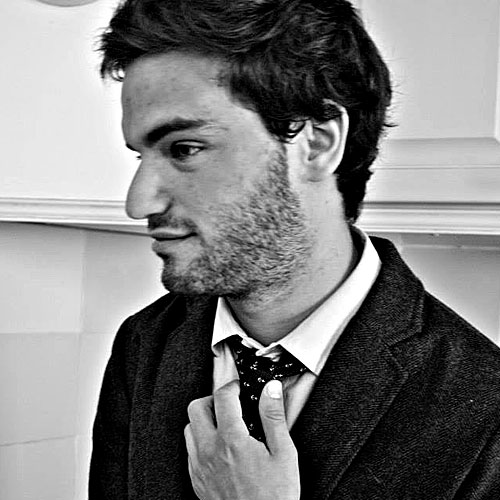The stakes of Netflix’s latest reality show, Dating Around, are radically low. On each episode, a man or woman go on five different blind dates. At the end, it’s revealed which suitor has won a second date. That’s it. Nobody even hooks up in a hot tub.
The first protagonist is a 27-year-old real estate agent named Luke. He’s tall and thinly muscular, with an outfit that’s stylish but not hip, formal but comfortable, well-fitting and ironed to a creaseless perfection. Like his clothing, Luke is funny without being edgy, sweet but not disingenuous, charming in an anodyne way. He goes on dates with a Jersey girl who chews loudly, a sensuous Columbian who teaches him how to salsa and a few others, though the one he chooses is a bit of a wild card, whose outsized personality seems to challenge him. It’s sort of surprising, sort of not.
Though the cast is diverse—in terms of race and gender, but also sexuality and age—Luke is a good person to start the series with, if only because he emblematizes the style of the show itself: cool and frictionless, as easy to digest as it is to forget. His personality, and the show’s, is the functional equivalent of a knife slicing smoothly through a stick of butter. There is no host on Dating Around. There are no voiceovers, unless you count the subtle introduction of the protagonists by their roommates or friends. Nor are there breaks for confessionals.
Each episode is broken up into three chapters—“Drinks,” “Dinner,” and the more up-for-grabs, “After Hours,” which take place in cabs or at another bar, if at all—followed by a daytime reveal. Its essential tension comes not from the flare-ups between suitors or the nature of the premise, as on Are You the One? and The Bachelor, but from the editing room, where snippets from each of the protagonist’s dates are spliced seamlessly together, culminating in a slow build. Given the lulling register it operates in, any deviation from the polite badinage—a man’s suggestion for his date to “relax”; a cultural discrepancy over marriage that crescendos into a brash indictment—becomes the dramatic equivalent of what a physical fight or trashy tonguing would be on another dating show. Dating Around is to other dating shows (particularly, the long-cancelled series, Elimidate) what Japan’s Terrace House is to MTV’s increasingly unpopular The Real World: paired down and understated and shrewdly observed, reality TV-qua-mumblecore. Another successful Netflix reality TV series, Tidying Up with Marie Kondo, is equally low-stakes; taken together, perhaps the popularity of these new iterations on the genre serve as a quiet reprieve to the concussive bombast of our reality TV presidency.
To its credit, the show works very hard to appear this effortless, this indifferent. What comes off as a facile naturalism between the daters is actually the result of a tightly controlled environment (not to mention, strong casting). The protagonists wear the same outfits to the five dates at the same bars and restaurants. They often order the same dishes and drinks. The suitor is treated as the independent variable in what is, for all intents and purposes, a kind of anthropological study.
And yet the show still manages to exude a verisimilitude unrivaled in reality TV, because first dates in real life are themselves heavily controlled environments. Those of us who have spent any significant time dating have our go-to spots, whether it be a bar or a restaurant. And our dates normally follow a similar trajectory. If all goes well, we go from drinks to dinner (or, more likely, more drinks), to a change of location and a thrilling walk or expectant Uber home, capped off with a kiss or an awkward, yearning hug. As with real life, the conversation on Dating Around ticks the boxes of a relatively standardized checklist—what do you do, where do you live, what were your relationships like in the past and what are looking for. Who amongst us hasn’t felt ourselves slide into the well-worn tracks of a practiced explanation regarding our ex-girlfriend, or a job, or our experience on dating apps? First dates are like interviews, and the show is well-aware of this, deploying almost identical anecdotes and responses as a lingua franca between the different dates. It’s deceptively post-modern: while other reality TV shows face criticism for being over-produced and manipulative and “fake,” the realest part of Dating Around may in fact be its complete and utter scripted-ness.
But the true success of Dating Around is in its warmth. It doesn’t turn romance into a spectacle, seeing as this isn’t a show about love, but about like. It can deliver on its premise—to find someone a second date—because it’s such a modest proposition to begin with. When Sarah, quirky and intelligent, meets a charmingly nerdy data scientist named Matt on the banks of the East River for a second date, their happiness feels genuine and earned.
Bound by limited ambitions, it also interrogates the reasons we watch these types of shows in the first place. The best episode stars a sexagenarian widower, Leonard, a former lawyer-turned-PI. He wears Chelsea boots, drinks a dry martini and looks like Gay Talese going undercover as a nebbish dad from NoHo. His frankness with his grief—as well as his empathic understanding of his dates’ various hardships—is tender and moving, a poignant jab at the prevailing shallowness of most reality TV. And seen in tandem with the rest of Dating Around, I found the likenesses—the conversational beats, the self-deprecating banter, the melancholic goodbyes—to be strangely consoling. No matter how old we get, the show suggests, dating never gets easier. Yet we persist, anyway.






